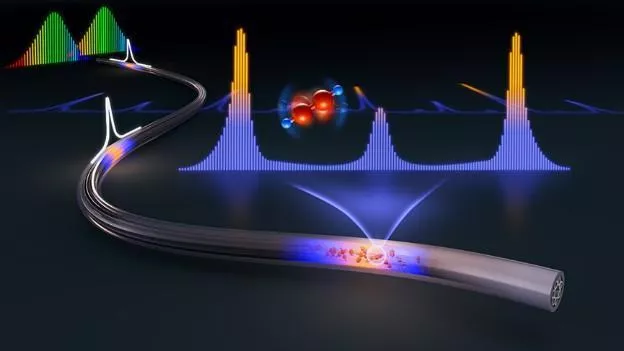According to xingdao.com, the engineering research team of the Chinese University of Hong Kong demonstrated the world's first dual comb photothermal spectrometer (dc-pts). This spectroscopy study confirmed that the relevant technology can complete a variety of gas measurements in one millisecond (thousandth of a second), and has high sensitivity to detect low concentration gases. The research will help to open up more applications of gas sensing technology, including toxic gas measurement, breath composition analysis including biomarkers of novel coronavirus, etc. The research results have been published in the academic journal Nature communication.

When the beams emitted by two coherent frequency combs (upper left corner) pass through the hollow optical fiber containing gas samples at the same time, each pair of frequency comb teeth will produce beat signals in the optical fiber, and the gas absorption will cause photothermal effect and change the refractive index of the gas. Source: Chinese University of Hong Kong
Ren Wei, associate professor of the Department of mechanical and automation engineering of CUHK, and his team and their partner, Changchun Institute of optics, precision machinery and physics, Chinese Academy of Sciences, jointly proposed a new gas measurement technology - double optical comb photothermal spectroscopy, which promoted gas sensing to a new level.
They use two groups of frequency combs to emit light beams with similar but different frequencies at the same time. When the light beam passes through the hollow optical fiber containing gas samples at the same time, it will cause an optical phenomenon called "heterodyne interference" and produce beat signal. The gas absorption will cause photothermal effect, so as to change the refractive index of the gas. The team used the instrument to measure the refractive index modulation at different frequencies, so as to obtain accurate spectral information and know the composition of gas samples.
At present, dc-pts can detect a variety of gases at the same time, including ammonia, carbon dioxide, carbon monoxide, hydrogen sulfide and hydrocarbons. Taking the colorless and flammable gas acetylene commonly used in industry as an example, the research team showed that dc-pts detected acetylene with a concentration of only 8.7ppm in the hollow optical fiber carrying only 0.17 μ l gas sample, realizing ppm gas detection sensitivity. On the contrary, traditional laser spectrometers are usually only equipped with single frequency laser, so they can only measure one gas at a time, and need about 100000 microliters (100 ml) of gas samples and longer test time to achieve the same detection sensitivity.
Human expiratory component analysis is one of the potential applications of dc-pts technology, such as the detection of compounds related to virus infection in respiratory samples. The traditional spectrometer or mass spectrometer often needs additional gas sampling steps, and its analysis time is also long; In contrast, dc-pts can provide more sensitive and faster chemical analysis in a wide spectral band, which can help to obtain more accurate test results.
Ren Wei said that this is the first dc-pts study in the world. This new high-precision spectral technology will help to realize the measurement of dozens to hundreds of gases in the future. He is actively developing the application of dc-pts in the analysis of expiratory components, especially the development of novel coronavirus breath test and chemical analyzer, to help solve the current epidemic and future public health emergencies. He added that relevant technologies also have considerable application potential in other areas of gas detection, including energy, environment and safety management.